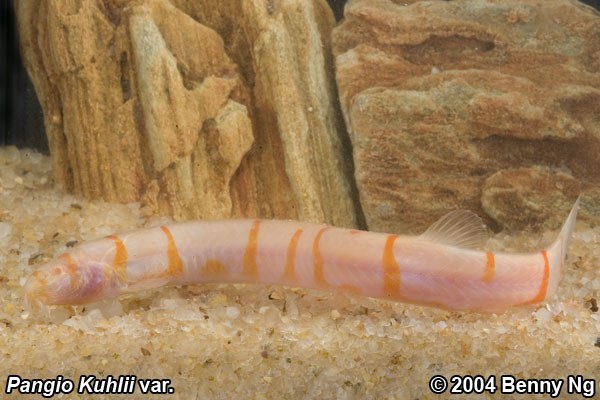Pangio myersi
Summary

Scientific Name: Pangio myersi (Harry, 1949)
Common name: Giant kuhli, Myer's loach, Myer's Kuhli.
Synonyms: Acanthophthalmus myersi
Distribution: Thailand, Laos, Cambodia
Sexual Dimorphism: Females noticeably plumper when loaded with eggs like other Pangio species. Eggs can often be seen though abdomen.
Maximum size: 4 inches (10 cm)
Similar to: Immature fish might be confused with other striped kuhlis. Adults are unmistakable.
Care: All kuhlis need well-established aquaria and should not be considered for newly set up tanks.
Lots of hiding places with soft substrate. Best kept in groups, the larger the better. Three fish is the absolute minimum that should be kept together.
Feeding: Easily fed. Accepts good quality flake, sinking pellets, thawed frozen bloodworm, Mysis shrimp, brine shrimp, etc.
Water parameters: pH: 6.5-7.2. Hardness: Medium Soft. Max dh: 5-12
Temperature: 78 - 82ºF (25.5 - 28ºC)
Breeding: Females become noticeably full of eggs. The male courts the female by wrapping his body around hers. Eggs, green in colour, are deposited in floating vegetation. Hatching occurs in approximately 24 hours.

Credit: Mark Macdonald
Notes
Truly the giant amongst Kuhli Loaches, Pangio myersi is fairly easily distinguishable due to its much heavier build and its thick black bars. Like all Kuhlis, this species loves planted aquaria with plenty of cover and ideally with some loose leaf litter. In nature, they habitually grub around for food particles in such areas.
Albino Pangio myersi sometimes appear in the ornamental fish trade and these usually command high prices. They can be both true albinos (red eyes) or hypo-melanistic which basically look the same, but have black eyes.

True albino form of P. myersi
Photo Gallery
Click to view all images of this species! |
|
Document Actions


